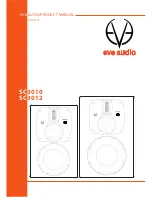
INTRODUCTION
Today’s recorded mediums are vastly superior to the recordings of just a few years ago. Unfortunately, many loudspeakers
available today cannot match the extended frequency response and dynamic range available from today’s digital sources, let alone
maintain compatibility with recording and playback advances yet to come.
Pro-Linear
loudspeakers are designed and engineered to meet your discerning requirements both today and in the future. Each
Pro-Linear
loudspeaker is rigorously engineered, crafted and tested to meet exacting standards for the reproduction of music from
all sources. From the delicacy of a violin concerto to the power and excitement of electronic rock or jazz, your new
high-performance loudspeakers handle the most demanding music with ease. A mere 5 watts of amplifier power will drive the
extremely efficient
Pro-Linear
speakers to thunderous levels.
CONNECTING YOUR LOUDSPEAKERS
Disconnect the power cord of your Receiver and set the volume to its minimum position before attempting to connect your
speakers and subwoofer. Set the POWER switch of your Active Subwoofer to the OFF position and rotate the VOLUME control to the
MIN position.
Please use 16 gauge (minimum) speaker wire to connect your speakers. When connecting, be careful to connect the red speaker
terminal to the red (+) terminal on your amplifier. The black speaker terminal should be hooked to the black (-) terminal on the
amplifier. The conductor wire is marked to simplify proper connection. One side of the wire will be identified by printing, a raised
ridge, or a different color conductor. Use this marked side for red (+)
.
To verify proper connection, switch your amplifier to MONO
and place your speakers close to each other. Adjust your balance control so that only one speaker is playing. Listen to the bass
level and adjust the balance control so that both speakers are playing. If the bass decreases when both speakers are playing, one
of the connections is wrong.
Double check the wiring after completing the connection. Plug in the AC power of both Active Subwoofer and your Home Theatre
Receiver. Move the POWER switch on the Active Subwoofer to the ON or AUTO position.
SPEAKER PLACEMENT
The performance of your new
Pro-Linear
loudspeakers, as with any high quality system, can be influenced by placement in your
listening room. Consider these rules as you select their positions:
1. You’ll find bass performance from your speakers affected by their placement in your listening room. Generally, more bass will be
generated the closer the speakers are to as many surfaces or corners (walls, floor, and ceiling) as possible. Conversely, the least
bass will be produced the further they are from the room surfaces. Your speakers have been designed to be in the most balance
when they share a wall and are within two feet of another surface. Don’t forget that you can “tune” the bass in your listening room
by shifting speakers towards (more and deeper bass) and away from (less and not as deep bass) the areas where room surfaces
meet.
2. The speakers should of course face your listening area in the room and ideally the grille fronts should be “aimed” towards ear
level.
FRONT SPEAKERS
Your
Pro-Linear
speakers are designed to produce a “stage like” image. To take full advantage of this feature the speakers should
be separated by about half the distance as they are from the listening location to the speakers. For example, if your listening
position is about 10 feet from the speakers, the left and right speakers should be about five feet apart. Please see Figure 1.
CENTRE CHANNEL SPEAKER
The
Pro-Linear
center channel should be centrally located between the left and right main channels, placed above or below the
television set. Be sure that the center channel speaker front grille is aligned with the front of the television, rack, or cabinet, to
maximize dispersion. Please see Figure 1.
SURROUND SPEAKERS
The
Pro-Linear
surround speakers can be positioned in a variety of locations, but ideally should be positioned on either side of the
listener. Please refer to Figure 1.































